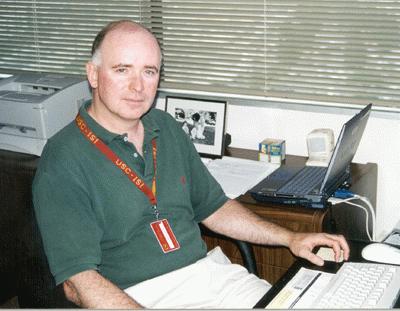
Bob Lucas
The USC Viterbi School of Engineering will take the lead on more than $20 million in new research programs announced September 7 by the US Department of Energy, and share in two more and ISI is involved in three of the four USC projects.
The DOE will annually grant more than $60 million in research funding under the SciDAC (“Scientific Discovery Through Advanced Computing“) program to some 30 programs at universities and government research labs across the country, “aimed at accelerating research in designing new materials, developing future energy sources, studying global climate change, improving environmental cleanup methods and understanding physics from the tiniest particles to the massive explosions of supernova,” according to the press announcement of the program.
The programs all deal with extremely large peta (1000 trillion) scale computing systems.
USC will take the lead on two of these studies:
- Robert F. Lucas, director of the division of computational sciences at ISI, is the lead investigator on a $15 million ($3 million per year for 5 years) study of “Performance Engineering Research: Enhancing the performance of SciDAC applications on petascale systems,” aimed at optimizing performance of such systems. Lucas will work with ISI computer scientists Mary Hall and Jacqueline Chame on the project, which will also collaborate with researchers in 9 other institutions.
- Priya Vashishta, who has a joint appointment in the Viterbi School’s departments of computer science and materials science and in the USC College department of physics and astronomy, will lead a $5.5 million study ($1.1 million per year for five years) on “Cracking Under Stress: Developing a petascale simulation framework for stress corrosion cracking.” The goal is create more accurate and useful models, at the atomic level, for understanding corrosion effects – which cost “3 percent of the U.S. gross domestic product annually,” according to Vashishta’s account. Vashishta will work with his longtime co-workers Rajiv K. Kalia and Aiichiro Nakano at USC, and with others at five oher institutions.
In addition, grid computing pioneer Carl Kesselman , director of the ISI Center for Grid Technologies, and Ann Chervenak, also of ISI, will work on two other SciDAC projects:
- “Getting the Science out of the Data: Scientific data management to help scientists spend more time studying their results and less time managing their data” is a $12 million effort ($2.4 million per year) to find better ways of either moving massive amounts of data “to where it is needed and/or enable analysis to occur near the data.” Kesselman worked with the study’s lead, Ian Foster, of Argonne National Laboratories, in developing the Globus grid computing open software system. In addition ISI and Argonne, three other institutions will participate in the effort.
- “Sharing a World of Data: Scaling the Earth Systems Grid to Petascale Data to enable faster, easier sharing of climate change research data,” is a $13.75 million ($2.75 million per year) project to deal with the “massive amounts of data that are distributed across the globe” relating to climate and possible climate change. The project is led by N. Dean Williams of Livermore National Laboratory. Among the scientists at six other institutions is Argonne’s Ian Foster.
“Advanced computing is a critical element of President Bush’s American Competitiveness Initiative and these projects represent an important path to scientific discovery,” DOE Under Secretary for Science Raymond Orbach said, in making the announcement. “We anticipate that they will develop and improve software for simulating scientific problems and help reduce the time-to-market for new technologies.”
A complete list of the SciDAC projects is at http://www.scidac.gov/highlights/06list.html













